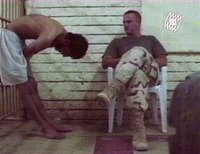The other day, Peter Manseau, editor of Killing the Buddha sent me an email with this quote from author Michael Tolkin's interview in the New York Times:
"I don't think America's had a good movie made since Abu Ghraib," Tolkin said, before clarifying that he's talking about big movies, not the minuscule ones that have met the industry's quotas for unembarrassing award nominees. "I think it showed that a generation that had been raised on those heroic movies was torturing. National myths die, I don't think they return. And our national myth is finished, except in a kind of belligerent way."
It's difficult to know whtat exactly he means by this, but I'm taking it as a statement about the provocative nature of the images and the way the images call the audience to reflect on not only the character of the American military but their own character, their own response to such images. Let's face it, very seldom do American films provide such a critique. "Boys Don't Cry," the fim that dramatized the life and death of Tina Brandon comes to mind, but I can't think of others off the top of my head.
This got me thinking about ground that I wanted to cover in my book (A Good War is Hard to Find) but just didn't have the space or the time. Might there be a connection between a national cinema that boldly deals with issues of pain, suffering, war and peace in earnest (unironic) ways and the peacefulness of that nation's people? I'm going to need some help from international film experts on this, but my instincts are leading me to think that there might be some truth in this.
The absolute dearth of American films critquing violence as a means of conflict resolution leads me to ask:
Is it plausible that American cinema is responsible for the degradation of a culture's moral imagination, its movement from a nation (prior to WWI) that looked upon war as a barbaric solution to a nation that largely supports violence as a means of achieving what is in the nation's "best interest"?
It's hard to know exactly which films Tolkin is critquing in his statement, but let's take a look the 1980s, since that was when I was doing my first movie-watching. Consider Rambo (especially part 2) Friday the 13th (and its interminable sequels and imitators) and Indiana Jones; in each, violence and identity stand in interesting relation.
Rambo II: Rambo wants to get even with American policy-makers who botched the Vietnam War by sending the cartoonish Army-of-One, Sly Stallone back into Vietnam to kick some Vietcong ass. Pauline Kael's review is a hilarious read as she skewers the film not only for the its crude appeals to the barely pubescent (Arrows tipped with explosive charges blowing up helicoptors) but also the disgruntled vets with not-so-subtle Christ imagery and troubling lines such as, "In order to survive in war you have to become like war." In effect, the film celebrates vigilante justice, critiques American foreign policy makers but, ultimately, further projects the myth that America's strength lies in its rugged individualism. Thus, we see the logic of the U.S. Army's current "Army-of-One" ad campaign: Entice a generation of young people cagey about authority to enlist in the military, a decision that signs away your civilian rights, by telling them that they will become "somebody"--the ultimate fighting machine.
Friday the 13th: Although intended as cheap thrills for teens, through the lens of Tolkin's comments, becomes a series of films that shows us teen on teen sex through the eye holes of a hockey-masked (he was badly burned as a child) serial killer who's pissed off because he's badly deformed and his mother is dead. This formula continues to be bankable, so much so that contemporary American culture is inundated with similar plots and images. There is an odd sickness in American male culture that makes us interested in the violent assault of beautiful woman. Men both revere and wish to protect beautiful women but also punish them for being so beautiful and therefore beyond attainment. Violence becomes associated with the sexual urge to both love and conquer at the same time. (Brett Easton Ellis' "American Pscyho" most recently and infamously explored this issue.)
Indiana Jones: While the most dear to my heart is, nonetheless, a film that portrays bearded men in turbans (Muslims) and men with sinister German accents and monocles (Nazis) teaming up to use the Ark of the Convenant, one of THE most powerfully holy relics to Judeo/Christian thinking, to, ostensibly, wipe out the Jews and the Americans. Hmmm.
What do these films have to do with Abu Ghraib, torture, and the American public's authorization of violence? Well, based on the research done by sociologists and psychologists on what motivates torturers, such films aren't necessarily creating torturers. On the whole, torturers see what they do as a job, a job that would be unncessary if only the subject would talk. Though this may be the case, it seems that Abu Ghraib is not so much about state mandated torture (although the boundaries of what is what is not torture do seem to have been intentionally blurry), it is about young people whose moral consciences did not cause them to balk and a citizenry that failed the same test.
Film studies folks have been thinking about the roots of misrepresentating the "other," and "problematically" totalizing the complexity of cultural identity, ethnicity, sexuality, etc. through the deployment of a subtle visual rhetoric, some of which is conscious and some of which is, arguably, subconscious. These scholars hold that film can call attention to such problems. Just look at countries along cultural fault lines, such as Irish and Mexican film: both deal quite literally with borders and the violence that erupts as a result of the tension between perspectives. In these films the violence is understood as symptomatic of deep social undercurrents.
The explication above is just a beginning, but I think it starts to get at the sinister undercurrents in American culture: how sex, violence, nationalism and religion are connected in the American psyche. The Abu Ghraib seem to be a nexus point for thinking about these connections in the American subconscious and how the connection influences the American mind.



